Class 11 Biology Chapter 14 Respiration in Plants, AHSEC Class 11 Biology Question Answer, HS 1st year Biology notes to each chapter are provided in the list so that you can easily browse throughout different chapters Assam Board Class 11 Biology Chapter 14 Respiration in Plants Question Answer and select needs one.
Class 11 Biology Chapter 14 Respiration in Plants
Also, you can read the SCERT book online in these sections Solutions by Expert Teachers as per SCERT (CBSE) Book guidelines. These solutions are part of SCERT All Subject Solutions. Here we have given Assam Board Class 11 Biology Chapter 14 Respiration in Plants Solutions for All Subjects, You can practice these here.
Respiration in Plants
Chapter – 14
VERY SHORT ANSWER TYPE QUESTIONS
Q.1. Where does the energy required for life process come from?
Ans :- The energy required for life process comes from foods.
Q.2. Name two photosynthetic organism.
Ans :- Cyanobacteria and green plants.
Q.3. Name the cells of green plant where photosynthesis occurs.
Ans :- The cells containing chloroplast photosynthesize.
Q.4. What is cellular respiration?
Ans :- The mechanism of breakdown of food material within the cells to release energy and trapping of this energy for the synthesis of ATP is cellular respiration.
Q.5. Where does the breakdown of complex molecular take place?
Ans :- The breakdown of complex molecules takes place in the cytoplasm and mitochondria.
Q.6. Define respiration.
Ans :- The breakdown of C-C bonds of complex compounds through oxidation within the cells, leading to release of considerable amount of energy is called respiration.
Q.7. Write the name of the compound which on oxidation release energy?
Ans :- Carbohydrate.
Q.8. In what form is energy stored in a cell?
Ans :- Energy is stored in the form of ATP in a cell.
Q.9. Name the organs present in plants for gaseous exchange?
Ans :- Stomata and lenticels.
Q.10. Write the reaction showing the complete combustion of glucose.
Ans :- C₆H₁₂O₆ + 60₂→6CO₂+6H₂O+ energy.
Q.11. Name the products released during respiration?
Ans :- Carbon-dioxide, water and energy are the products released during respiration.
Q.12. Which organism are adapted to anaerobic conditions?
Ans :- Facultative anaerobes.
Q.13. What is glycolysis?
Ans :- The breakdown of glucose to pyruvic acid is called glycolysis.
Q.14. Who gave the scheme of glycolysis?
Ans :- The scheme of glycolysis was given by Gustav Embden, Otto Meyerhof and J. Parnas.
15. Where does glycolysis occur in the cell?
Ans :- Glycolysis occurs in the cytoplasm of the cell.
Q.16. From where is glucose derived in plants?
Ans :- Glucose is derived from sucrose, the end product of photosynthesis.
Q.17. Name the enzyme which converts sucrose into glucose.
Ans :- Invertase.
Q.18. What is the end product of glycolysis?
Ans :- Pyruvic acid is the end product of glycolysis.
Q.19. Name the different ways in cells by which pyruvic acid is handled?
Ans :- Lactic acid fermentation, alcoholic fermentation and aerobic respiration.
Q.20. What is fermentation?
Ans :- The incomplete oxidation of glucose under anaerobic condition in which pyruvic acid is converted to Co₂ and eth anol is called fermentation.
Q.21. Name the enzymes involved in fermentation process?
Ans :- The process by which ATP is synthesised by the cells (in mitochondria and chloroplast) is called phosphorylation.
Q.22. What is lactic acid fermentation?
Ans :- In muscle cells, when oxygen is inadequate, pyruvic acid is reduced to lactic acid by lactic acid dehydrogenase.
Q.23. What is aerobic respiration?
Ans :- Aerobic respirations is the process that leads to a complete oxidation of organic substances in the presence of oxygen. And releases Co 2 water and a large amount of energy.
Q.24. Write the summary equation for krebs cycle.
Ans :-

3CO₂+4NADH+4H⁺+FADH₂+ATP
Q.25. What is electron transport system?
Ans :- The metabolic pathway through which the electron passes from one carrier to another is called electron transport system (ETS).
Q.26. What is cytochrome C?
Ans :- Cytochrome C is a small protein attached to the outer surface of the inner membrane.
Q.27. How many ATP are formed from oxidation of one molecule of NADH?
Ans :- 3 molecules of ATP are formed by the oxidation of one molecule of NADH.
Q.28. How many ATP molecules are formed during aerobic respiration of one molecule.
Ans :- 36 ATP molecules are formed during aerobic respiration.
Q.29. Why is the respiratory pathway called amphibolic pathway rather than catabolic?
Ans :- Because the respiratory pathway is involved in both anabolism and catabolism, hence it is called amphibolic rather than catabolic process.
Q.30. What is respiratory quotient?
Ans :- The ratio of the volume of CO₂ evolved to the volume of O₂ consumed in respirations called respiratory quotient (RQ).
Read Also: Health Benefits of Brinjal (Aubergine)
SHORT ANSWER TYPE QUESTIONS
Q.1. What are respiratory substrate?
Ans :- The compounds that are oxidised during the breaking of C-C bonds of complex compound through oxidation process (i.e respiration) are known as respiratory substrate.
Q.2. Why ATP is said to be the energy currency of the cell?
Ans :- The energy released by oxidation in the respiration process is not used directly but used to synthesis ATP, which is broken whenever and wherever energy need to be utilised. So ATP is said to be the energy currency of the cell.
Q.3. Give reasons why plant can get along without respiratory organs?
Ans :- Plants can get along without Respiratory organs dure to the following reasons:
i) Each plant part takes care of its own gas-exchange needs.
ii) Plants do not present great demands for gas exchange.
Q.4. Most cells of a plant have at least a part of their surface in contact with air comment.
Ans :- The stems have opening called lenticels for gaseous exchange. The cells in the interior are dead and provide only mechanical support. This is also facilitated by the loose pairing of parenchyma cells in leaves. Stems and roots, which provide an interconnected network of air spaces.
Q.5. Write the steps involved in glycolysis.
Ans :-
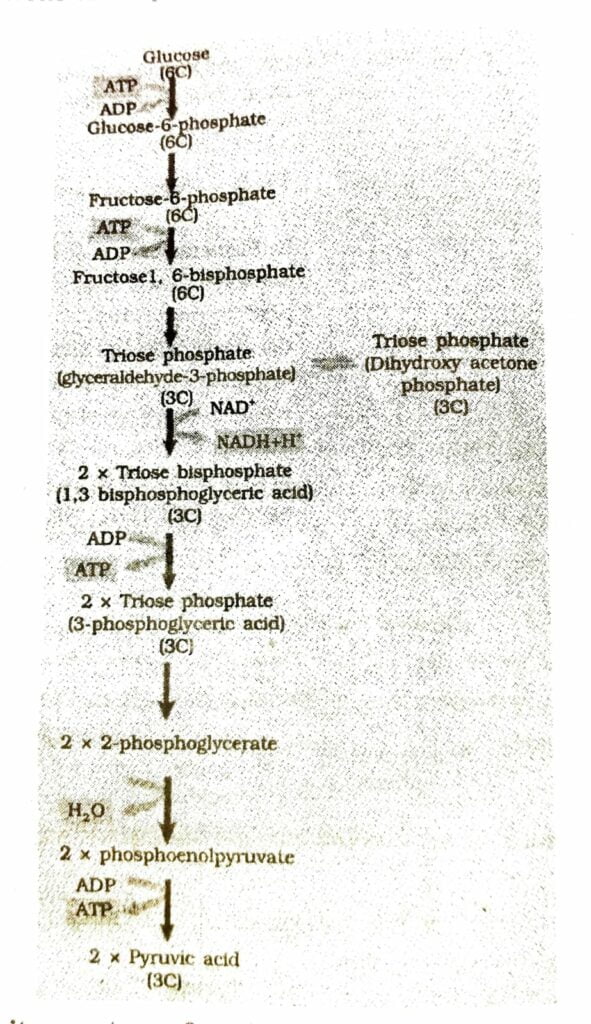
Q.6. Write a note on fermentation.
Ans :- In yeast cell, incomplete oxidation of glucose is achieved under anaerobic condition by sets of reactions where pyruvic acid is converted to Co₂ and ethanol. The enzyme, pyruvic acid decarboxylase and alcohol dehydrogenase catalyse the reaction. This process is known as fermentation.
Q.7. What are the crucial events in aerobic respiration?
Ans :- The crucial events in aerobic respirations :
i) The complete oxidation of pyruvate by the stepwise removal of all the hydrogen atoms, leaving three molecules of Co₂.
ii) The passing on of the electrons removed as part of the hydrogen atoms to molecular oxygen with synthesis of ATP.
Q.8. Two molecules of NADH are produced from two molecules of pyruvic acid. Explain.
Ans :- Pyruvate, which is formed by the glycolytic catabolism of carbohydrate after it enters mitochondrial matrix undergoes oxidative decarboxylation in presence of pyruvic dehydrogenase.
Pyruvic

CoA+Co₂+NADH+H⁺
During this process, 2 molecules of NADH are produced from two molecules of pyruvic acid.
Q.9. Explain Electron transport system.
Ans :- The metabolic pathway through which the electron passes from one carrier to another, is called the electron transport system (ETS) and it is present in inner mitochondrial membrane. Electrons from NADH produced during citric acid cycle are oxidised by an NADH produced during citric acid cycle are oxidised by an NADH dehydrogenase. and electrons are than transferred to ubiquinone. The reduced ubiquinone is then oxidised with the transfer of electrons to cytochrome C via cytochrome bcl.
When electrons pass from one carrier to another in the electron transport system, they are coupled to ATP synthetase for the production of ATP from ADP and inorganic phosphate.
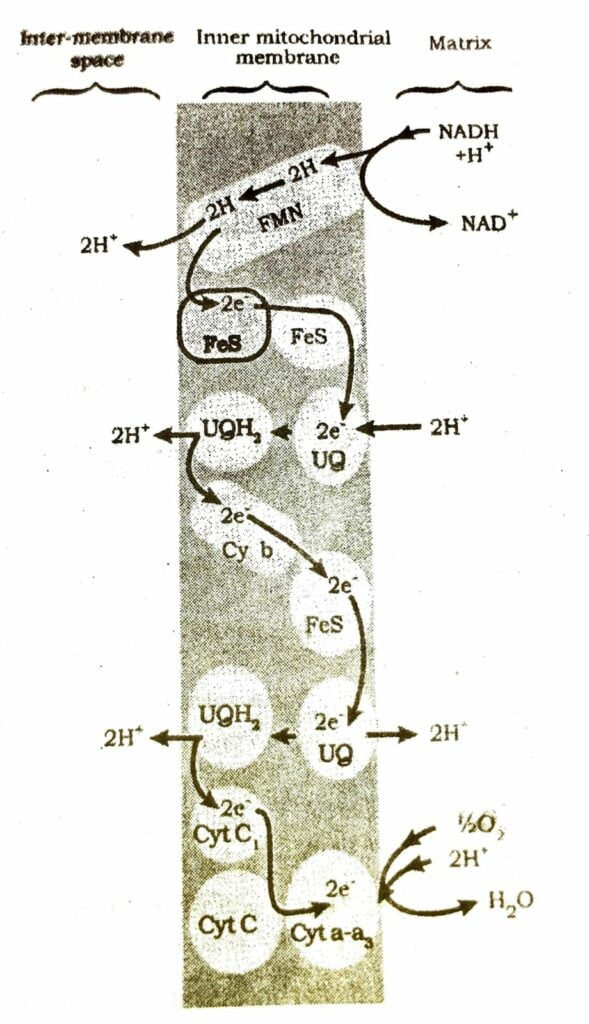
Q.10. Differentiate between fermentation and aerobic respiration.
Ans :- Fermentation:
i) It accounts for only a partial breakdown of glucose.
ii) There is a net gain of 2 molecule of ATP for each glucose molecule.
iii) NADH is oxidised to NAD+ slowly in fermentation.
Aerobic respiration:
i) Complete breakdown of glucose to Co₂ and H₂O.
ii) Many more ATP molecules are generated in aerobic respiration.
iii) Reaction is vigorous in aerobic respiration.
Q.11. Diagrammatically express the interrelationship among metabolic pathways.
Ans :-
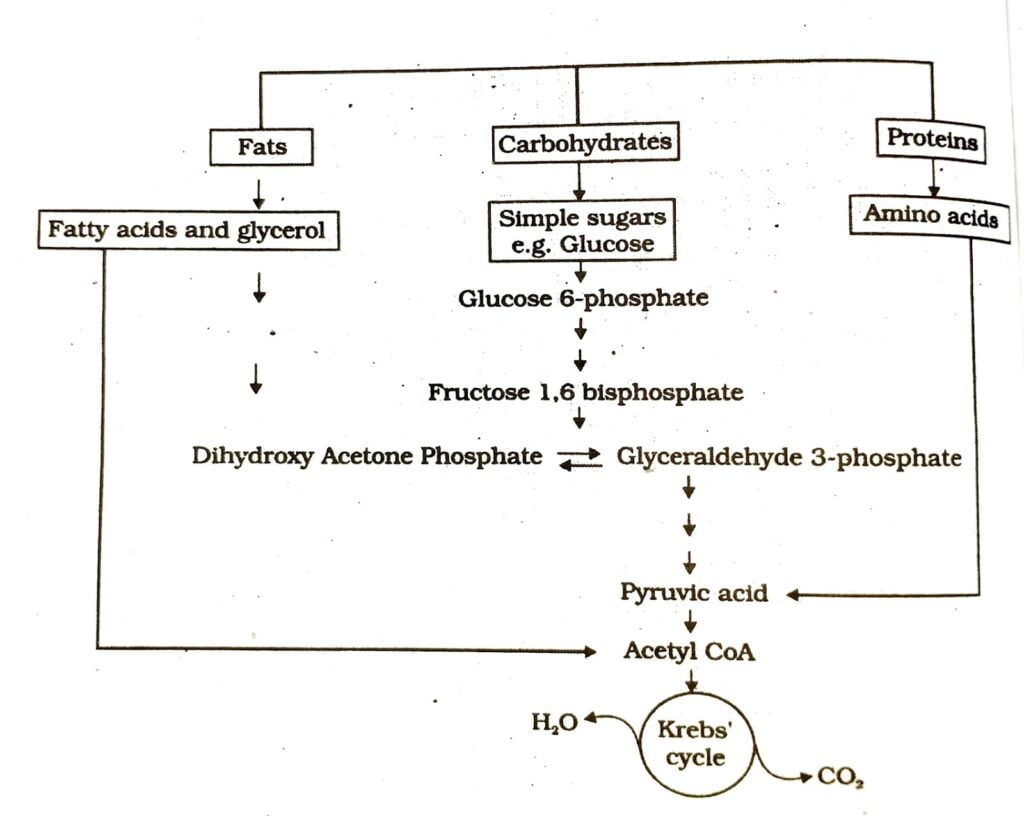
Q.12. What is the value of respiratory quotient for carbohydrate, fats and protein.
Ans :- When carbohydrate are used as substrate and are completely oxidised, RQ will be I, because equal amount of Co₂ and O₂ are evolved and consumed
When fats are used in respiration, RQ is less than I.
When protein are respiratory substrate, the ratio will be about 0.9.
Q.13. Why glycolysis is also known as EMP pathway?
Ans :- Glycolysis is also known as E.M.P. (Embden, Meyerhoff, Parnas) Pathway because the biochemical path of glycolysis was first worked out by three biochemist namely embden, meyerhof and Parnas and to honour these three biochemist, it is named as E.M.P. pathway.
Q.14. Why krebs cycle is also called TCA cycle?
Ans :- Krebs cycle is named after the name of Sir Hans Kreb who first described all the reaction involved in the cycle. Kreb’s cycle is also known as citric acid cycle because the first product of the cycle is citric acid. Citric acid having 3 carboxyl group, the cycle is hence also known as tricarboxylic acid cycle or TCA cycle.
Q.15. Distinguish between glycolysis & Krebs cycle.
Ans :-
| Glycolysis | Krebs cycle |
| 1. Occurs in cytoplasm. | 1. Occurs in matrix of mitochondria. |
| 2. Occurs both in anaerobic & aerobic respiration. | 2. Occurs only in aerobic respiration. |
| 3. 2 ATP molecules per glucose molecules are produced. | 3. 2 GTP molecules are produced from 2 molecules of acetyl coA. |
| 4. End products are 2 molecules of pyruvic acid from one glucose molecule. | 4. End product of acetyl coA are Co₂ and water molecules. |
| 5. Co₂ is not produced. | 5. Co₂ is evolved in the process. |
Q.16. Describe the process of lactic acid fermentation and alcoholic fermentation.
Ans :- Lactic acid fermentation :- In this type of fermentation, the last product of glycolysis pyruvic acid is converted into lactic acid by enzyme lactic dehydrogenase. It occurs in muscle cells.
CH₃CO.COOH + NADH₂ —— CH₃ CHOHCOOH+NAD (Lactic acid)
Alcoholic Fermentation – In the type of anaerobic respiration pyruvic acid at first undergoes decarboxylation to produce acetaldehyde in presence of an enzyme pyruvate decarboxylase.
2CH₃CO.COOH ———- 2CH₃ CHO+2CO₂.
(Pyruvic acid) (Acetaldehyde)
Q.17. What is electron transport system and electron transport chain?
Ans :- In aerobic organism the ultimate electron is molecular oxygen (O₂) so the free electron which first appears with the reduction of NAD⁺ to NADH finally accepted by molecular oxygen. As in this process, the transfer of electrons takes place, it is called electron transport system (ETS).
Electron transport chain: Involves release of 2H atoms which is picked up by various coenzyme ( NAD⁺, NADP⁺, FAD etc) and get reduced. The reduced coenzyme ( ADH, NADPH, FADH2 etc) transfer electron and proton through a series of carrier ( cytochrome) until react with O₂ to form H₂O sequence of electron carrier is known as electron transport chain.
Reduced electron carrier +O₂ —–Oxidised carrier +H₂O.
Q.18. What is oxidative phosphorylation?
Ans :- In electron transport chain the cytochrome act as carrier of electron. When cytochrome transfers electron to other cytochrome the potential energy of the electron is released and is trapped by ADP and inorganic phosphate molecule to from one molecule of ATP.
ADP + iP + energy-ATP.
During ETS, ATP formation takes place due to the oxidation of organic food Hence, the process of formation of ATP molecules during electron transport chain is termed as oxidative phosphorylation.
LONG ANSWER TYPE QUESTIONS
Q.1. Explain briefly the steps involved in glycolysis
Ans :- The term glycolysis has originated from the Greek words, glycos for sugar and lysis for splitting. The Scheme of glycolysis was given by Embden, Meyerh of and parnas and is referred as EMP pathway.
Glycolysis occurs in the cytoplasm of the cell. In this process, glucose under goes partial oxidation to form to 2 molecules of pyruvic acid. Glucose and fructose are phosphorylated to give rise to glucose -6- phosphate by enzyme hexokinase. Glucose -6- phosphate then isomerase to produce fructose 6 phosphate.ATP is utilised at two steps first in the conversion of glucose to glucose 6 phosphate and second in the conversion of fructose 6 phosphate to fructose 1, 6, biphosphate. Fructose 1, 6- biphosphate is split in to dihydroxyacetone phosphate and 3 phosphoglyceraldehyde (PGAL). At one step NADH+H+ is formed from NAD+, this is when 3-PGAL is converted to 1, 3-diphosphoglycerate PGAL is oxidised and with inorganic phosphate to get converted into BPGA. The conversion of BPGA to 3- phosphoglyceric acid (PGA), is also an energy yielding process. At this step too energy is stored as ATP Another ATP is synthesised during the Conversion of PEP to pyruvic acid Pyruvic acid is the key product of glycolysis.
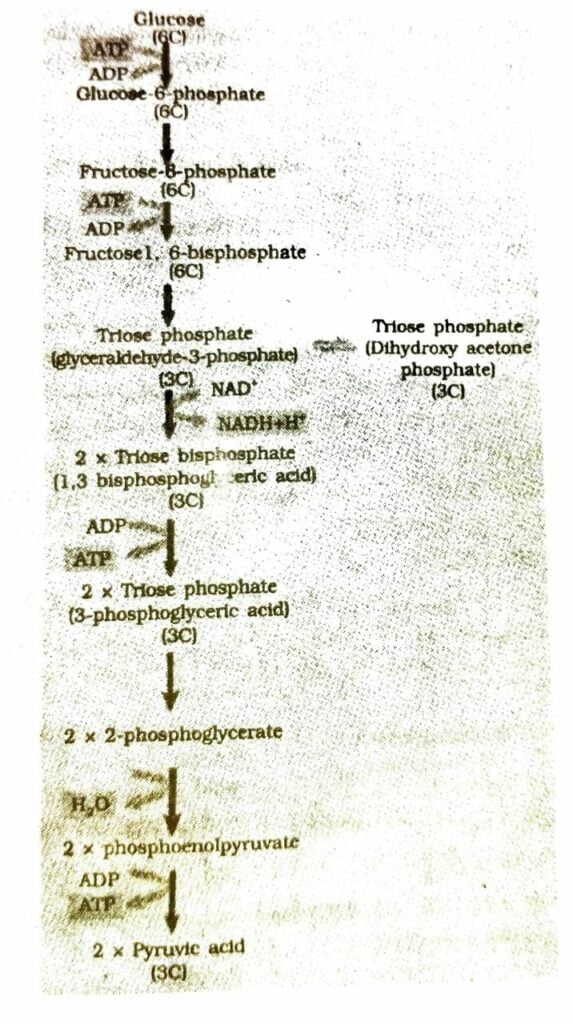
Q.2. What are the different types of fermentation?
Ans :- In fermentation, the complete oxidation of glucose occurs under anaerobic condition where pyruvic acid is converted to Co₂ and ethanol. Pyruvic acid decarboxylase and alcohol dehydrogenase catalyse the reaction.
In animal cells also, like muscles during exercise, when oxygen is inadequate for cellular respiration, pyruvic acid is reduced to lactic acid by lactate dehydrogenase.
In both lactic acid and alcohol fermentation not much energy is released, less than 7% of the energy in glucose is released.
Reaction in alcoholic fermentation:

Q.3. Explain Tricarboxylic acid cycle with along with schematic representation.
Ans :- The Tricarboxylic acid cycle starts with the condensation of acetyl group with oxaloacetic acid (OAA) and water to yield citric acid. The reaction is catalysed by citrate synthetase. Citrate is then isomerized to isocitric. It is followed by two steps of decarboxylation, forming a-ketoglutaric acid and then succinyl CoA. Succinyl CoA is oxidised to OAA. During the conversion of succinyl CoA to succinic acid, a molecule of GTP is synthesised.
There are three points in the cycle where NAD+ is reduced to NADH+H+ , and one point where FAD⁺ is reduced to FADH₂.
The summary equation for this phase of respirations as follows.

3CO₂+4NADH+4H⁺+FADH₂+ATP.
Thus glucose has been broken down to release Co₂ and 8 molecule of NADH+H⁺, two of FADH₂ have been synthesised.
Q.4. What are the assumptions made during the calculation net gain of ATP?
Ans :- It is possible to make calculation of the net gain of ATP for every glucose molecule oxidised. These calculations can be made only on certain assumptions that :
i) There is a sequential, orderly pathway functioning, with one substrate forming the next with glycolysis, TCA cycle and ETS pathway following one after another.
ii) The NADH synthesised in glycolysis is transferred into the mitochondria and undergoes oxidative phosphorylation.
iii) None of the intermediate in the pathway are utilised to syntheses any other compound.
iv) Only glucose is being respired no other alternative substrate are entering in the pathway at any of the intermediary stages.
All pathway work simultaneously and do not take place one after another substrates enter the pathways and are withdrawn from it as and when necessary, ATP is utilised as and when needed. Hence there can be a net gain of 36 ATP molecules during aerobic respiration of one molecule of glucose.
Q.5. Describe in brief the oxidative Phosphorylation during electron transport system.
Ans :- The CO₂ released from krebs cycle is shifted to the cytoplasm and at last it is expelled from the body. It is to be noted that the enzyme released in kreb cycle is not produced by the combustion of c-atom to glucose by released H-atom. Soler energy remain entrapped in the C-H bond of glucose molecule and during krebs cycle this bond become weak when H atoms are replaced and energy is released in the electron of H-atom.
H atom immediately dissociates in to H⁺and H-H⁺+e.
Hydrogen ions are expelled from the energy rich electron n to remain inside and in presence of several enzymes such as NAD, FAD cytochrome etc. The electron are converted to energy less particle though a series of oxido reduction reaction. During this process ADP of mitochondria transform into ATP using energy released by electron.
The energy less electron now become stable and H+ to form water molecule to be released from body during expiration.
Q.6. Where in the mitochondria does the krebs cycle occur? What is the relation between the process of glycolysis, Krebs cycle and electron transport in the mitochondria.
Ans :- Krebs cycle occurs in the cristae of mitochondria.
Glycolysis Krebs cycle and electron transport are the steps included in the process of cellular respiration. During glycolysis glucose is converted into pyruvic acid and 2 ATP are produced pyruvic acid enters in to the mitochondrial complex and get oxidised to acetyl CoA. CoA to further oxidised on entering TCA cycle where it yields Co₂ and reducted enzyme such as NADH and FADH₂.
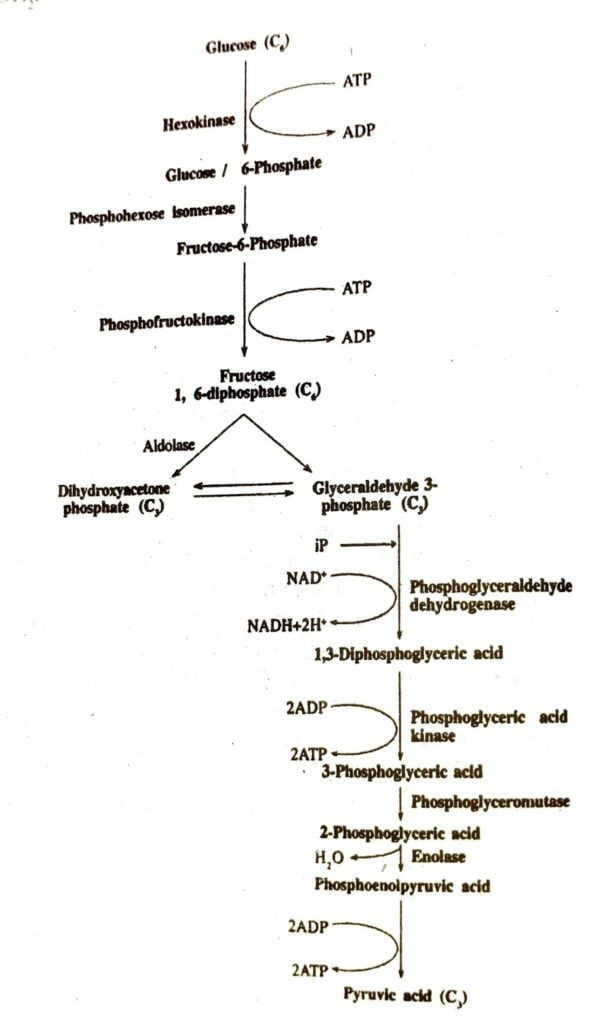
The reduced coenzyme are reported in electron transport chain. The enzymes of electron chain present in the career mitochondrial membrane transport electron to molecular oxygen. In this process free chemical energy is liberated. The energy is utilised in phosphorylation of ADP to synthesise ATP. In aerobic respiration one molecule of glucose give net yield of 36 molecule of ATP and 2 ATP gained in glycolysis.

Hi, I’m Dev Kirtonia, Founder & CEO of Dev Library. A website that provides all SCERT, NCERT 3 to 12, and BA, B.com, B.Sc, and Computer Science with Post Graduate Notes & Suggestions, Novel, eBooks, Biography, Quotes, Study Materials, and more.




